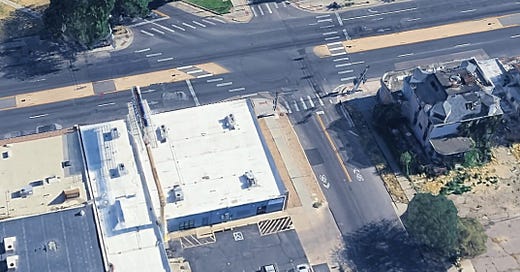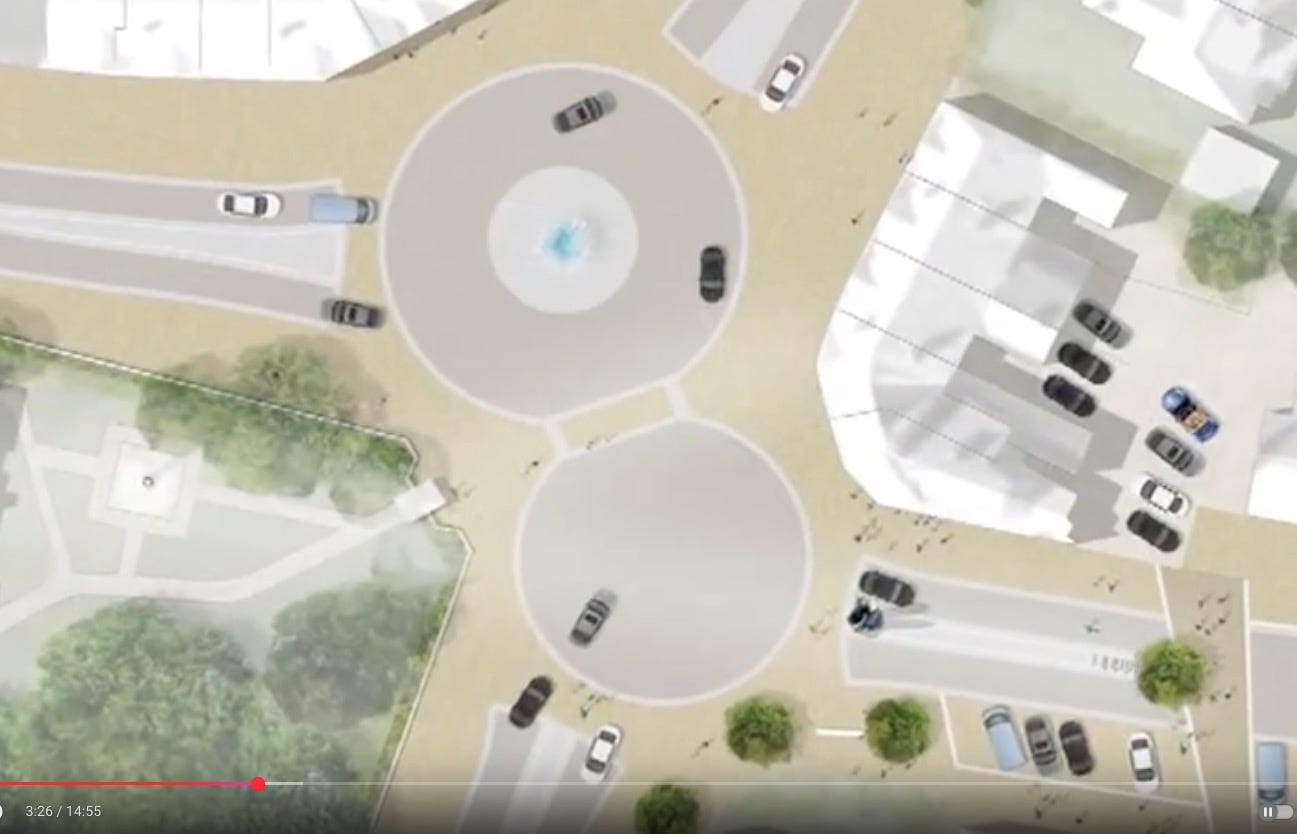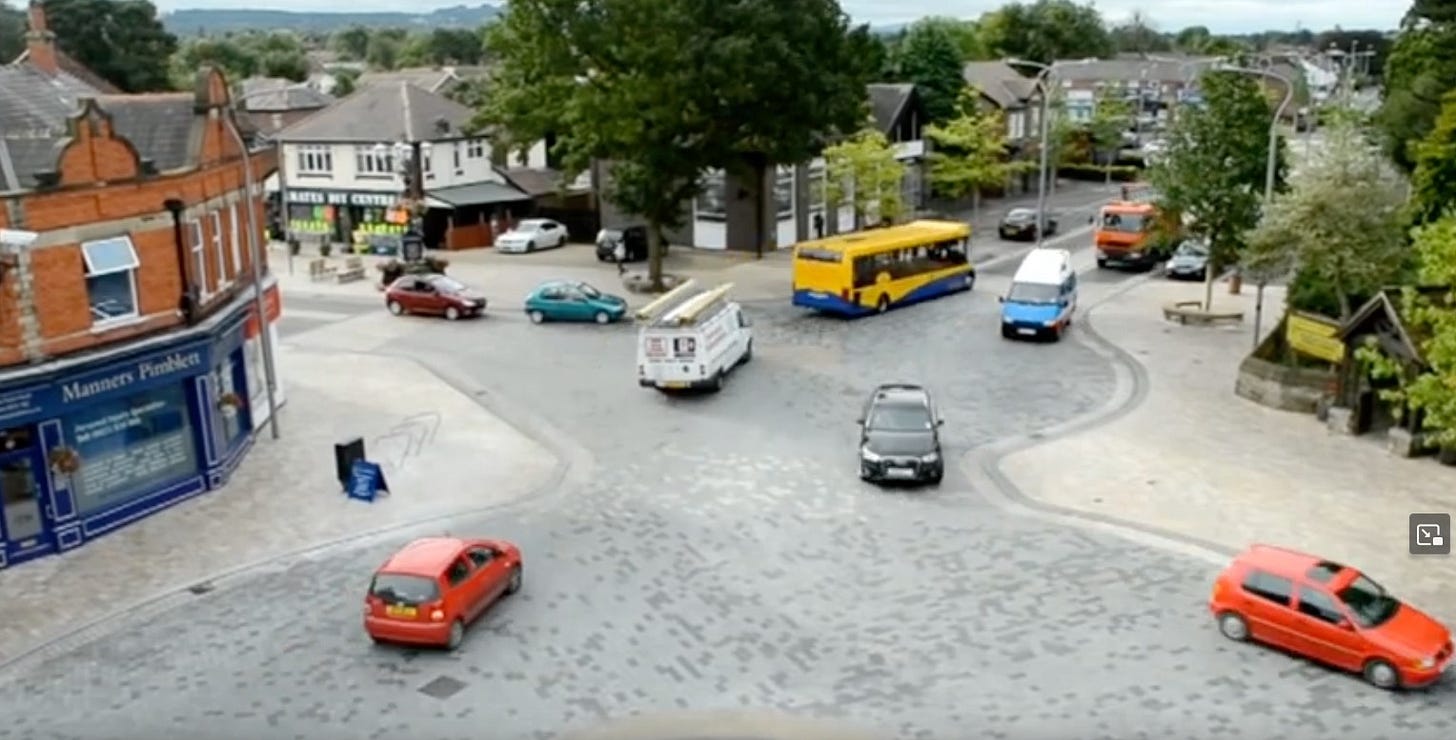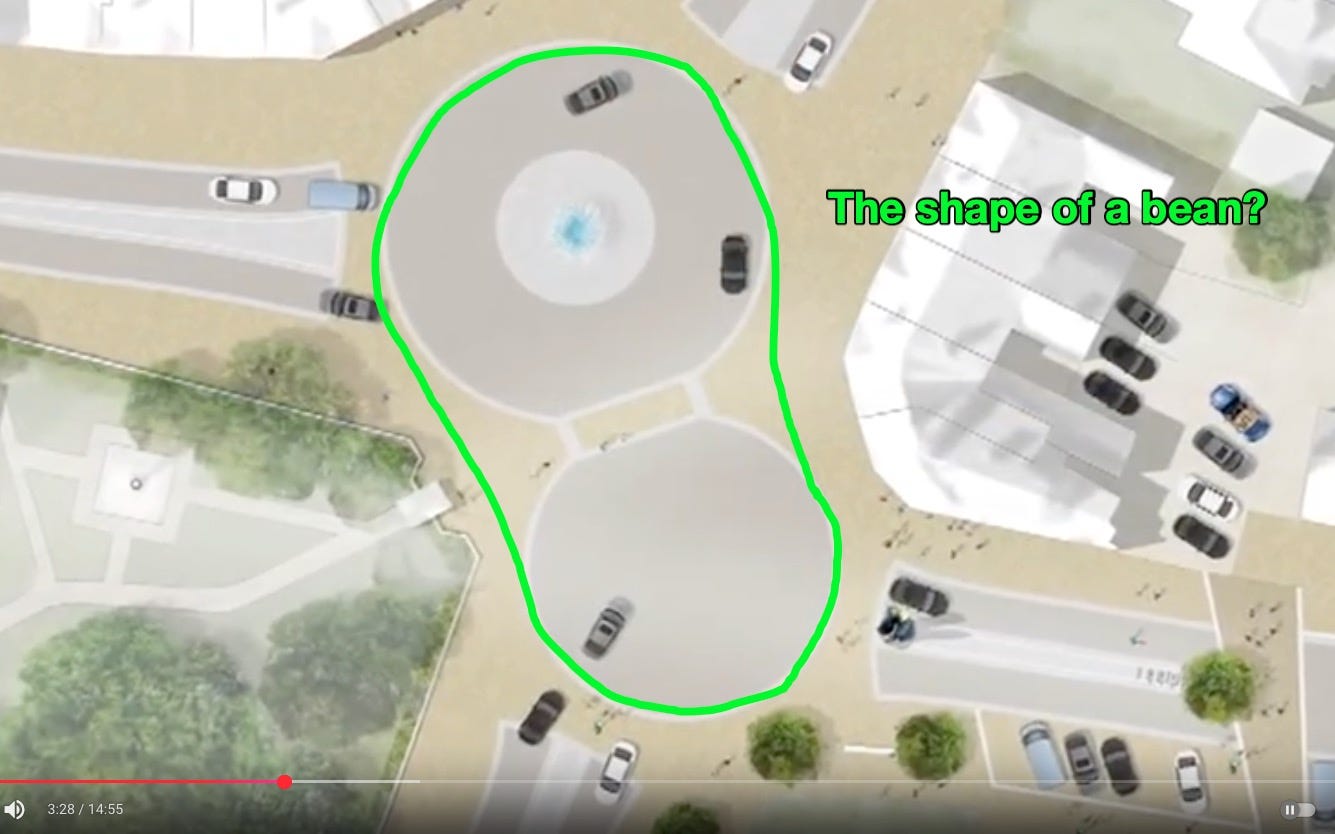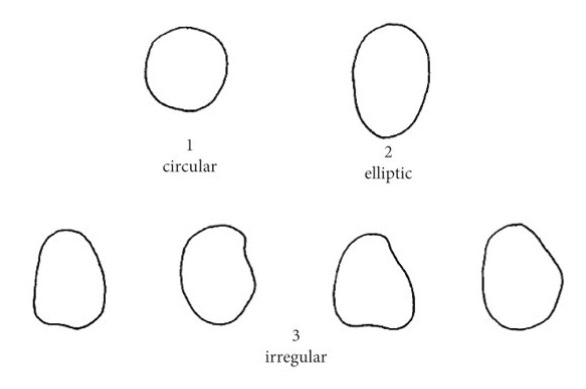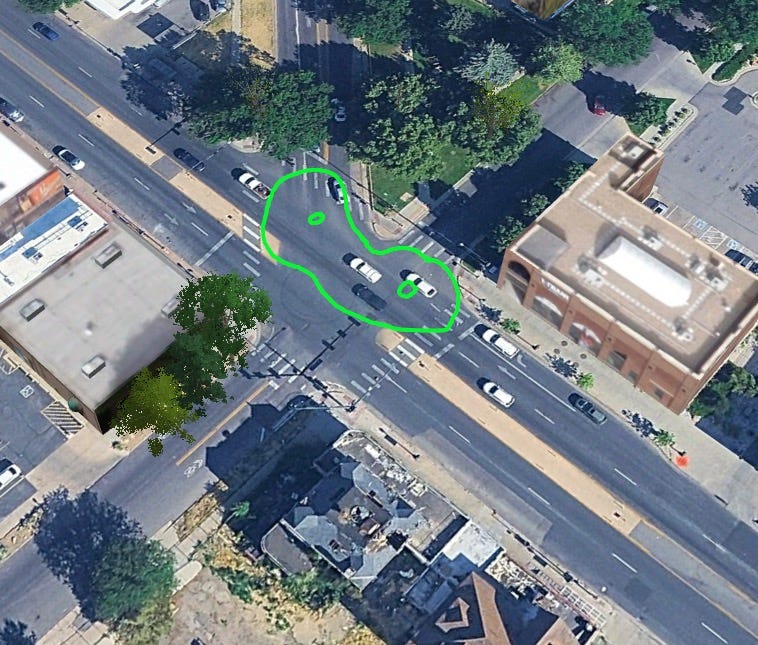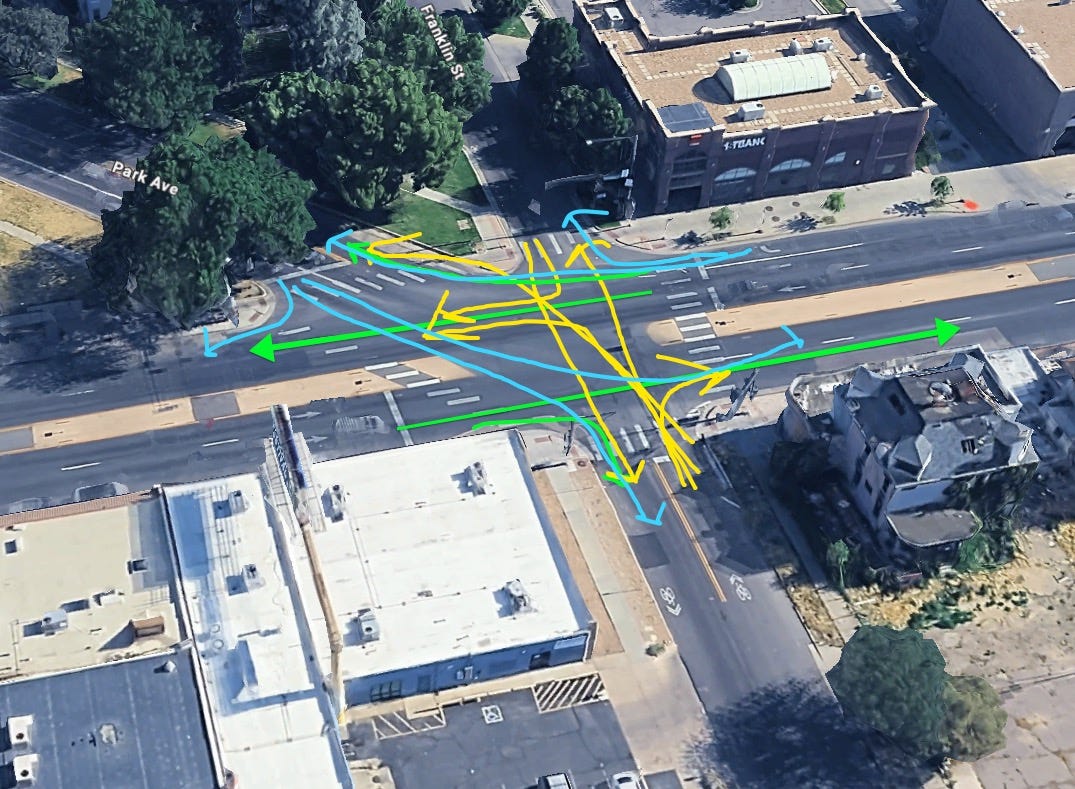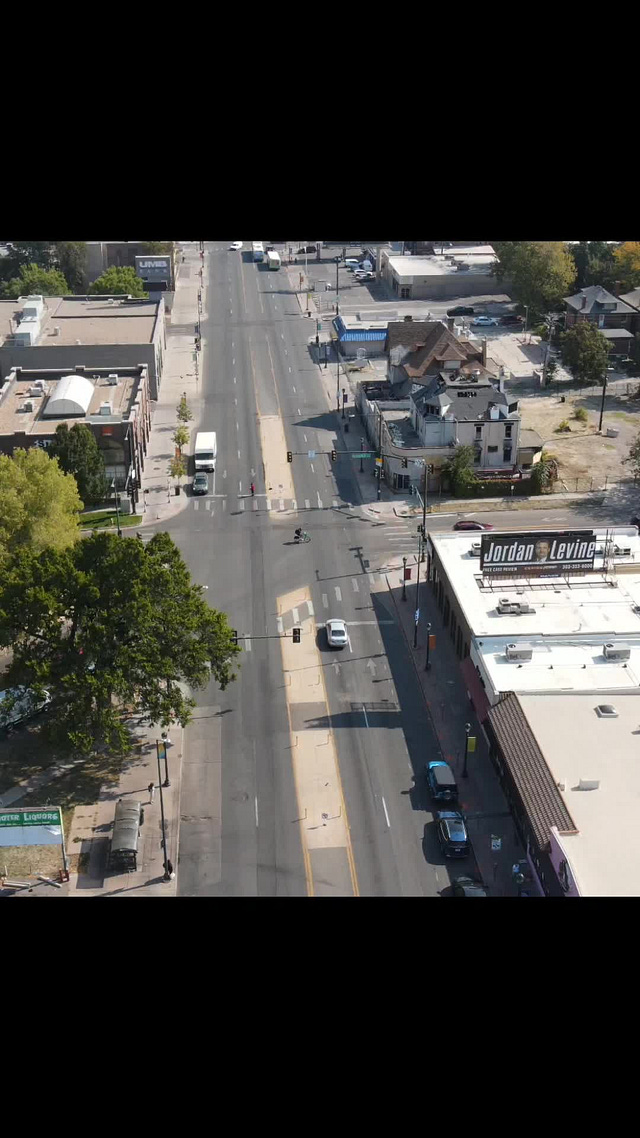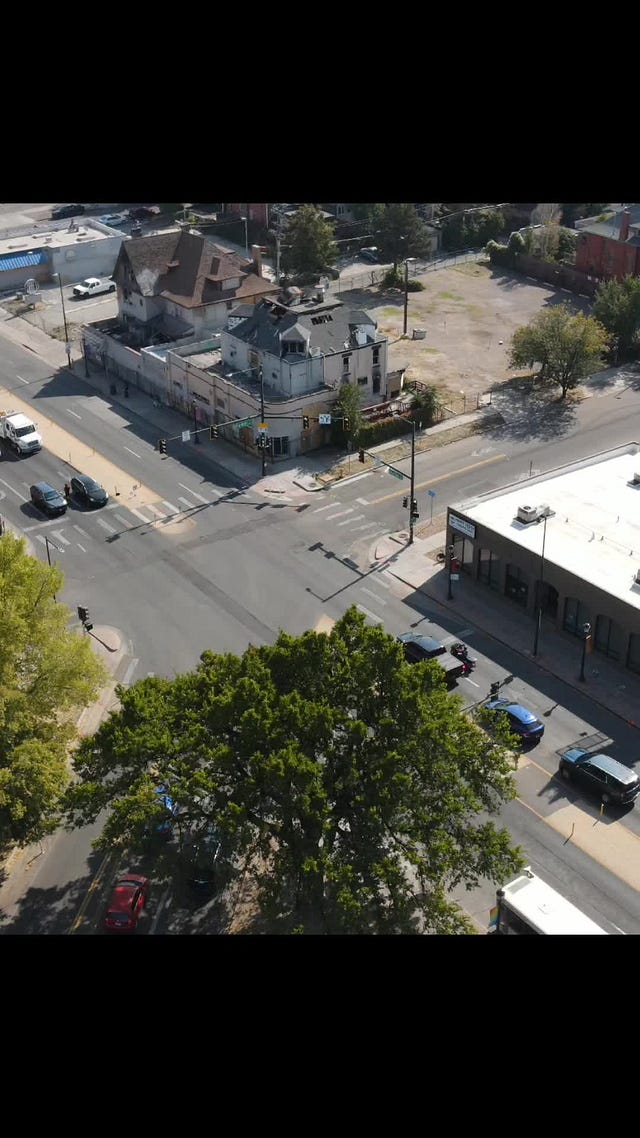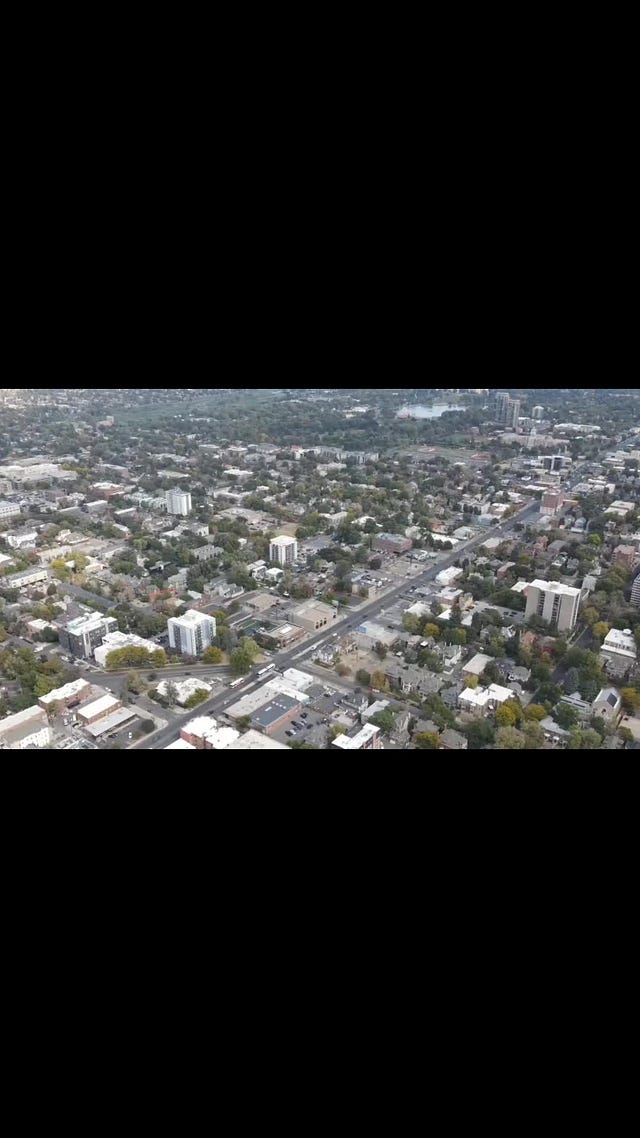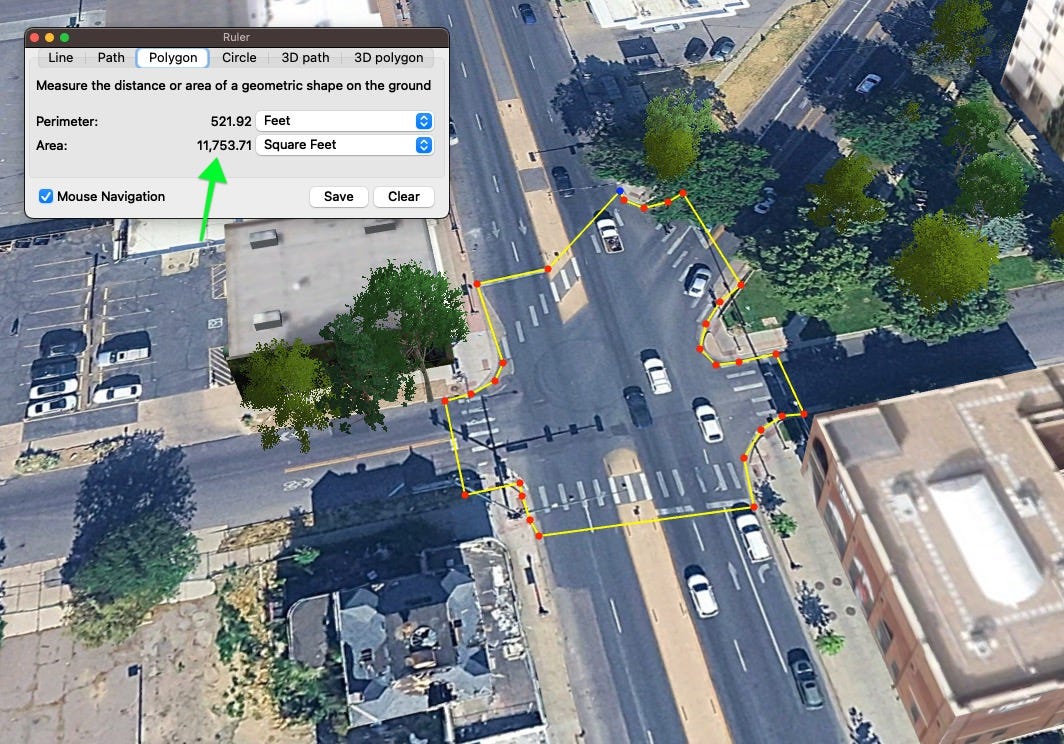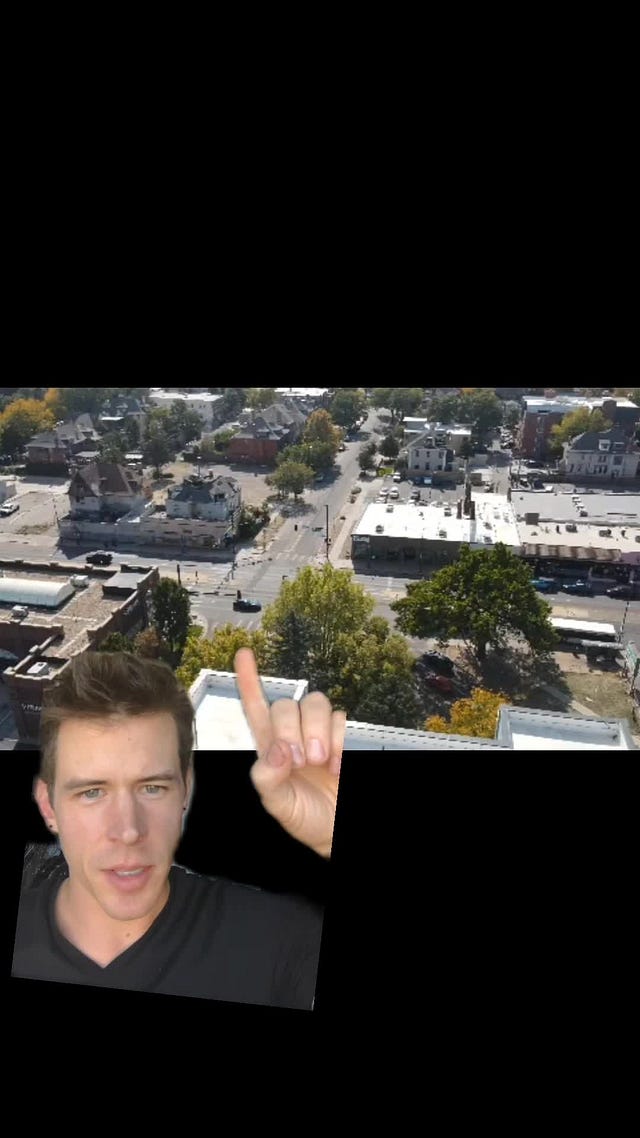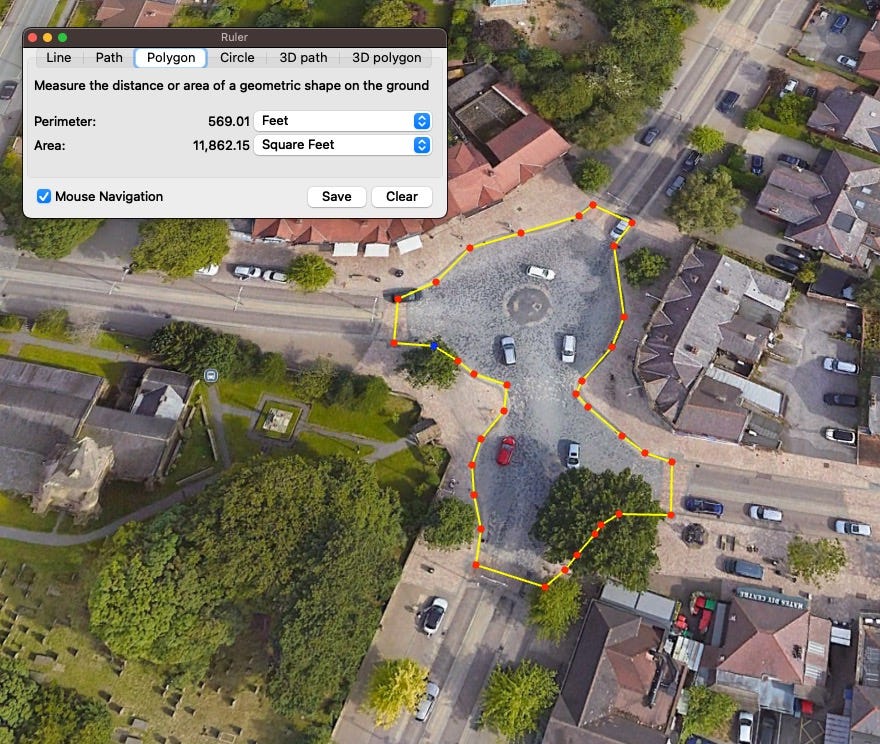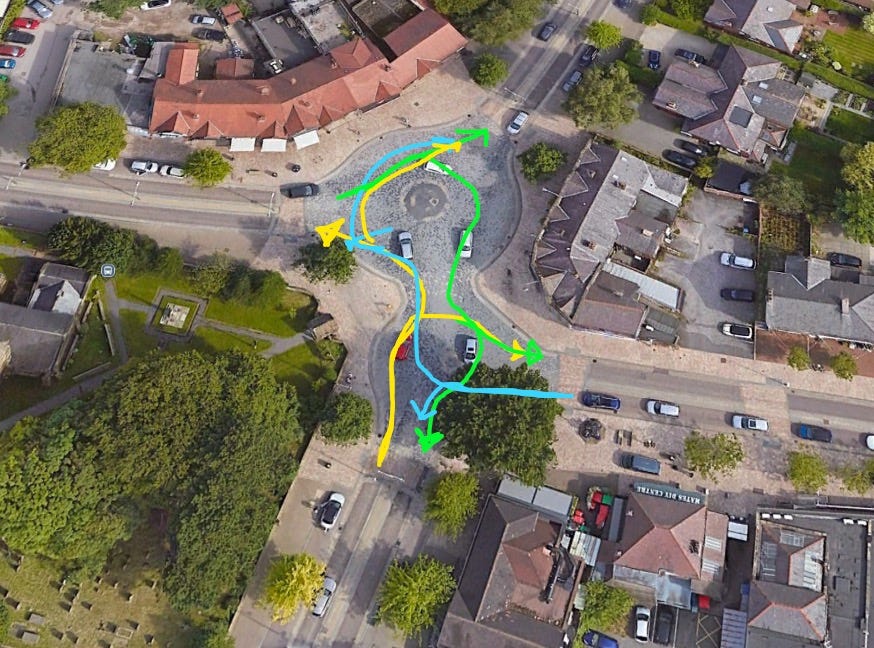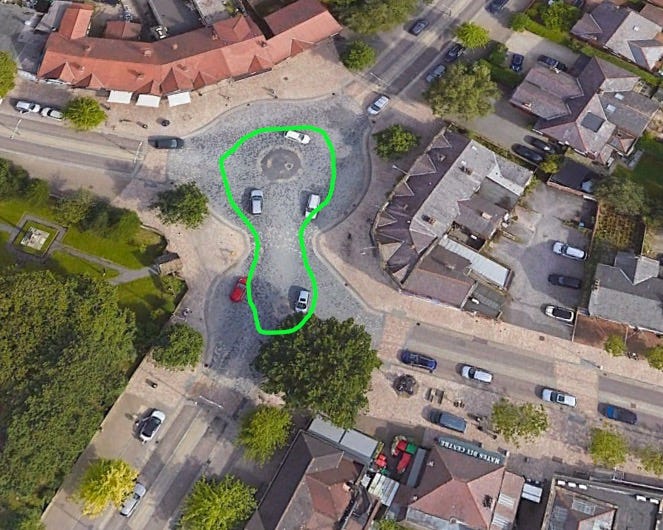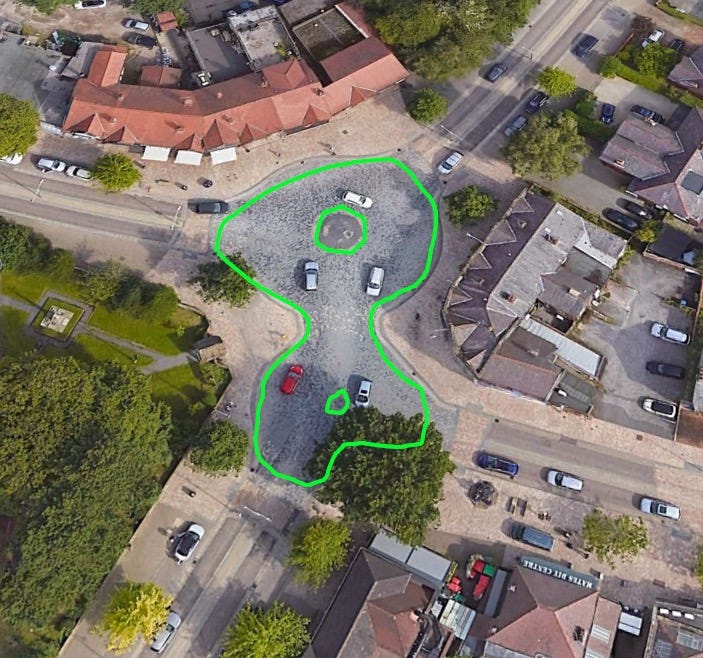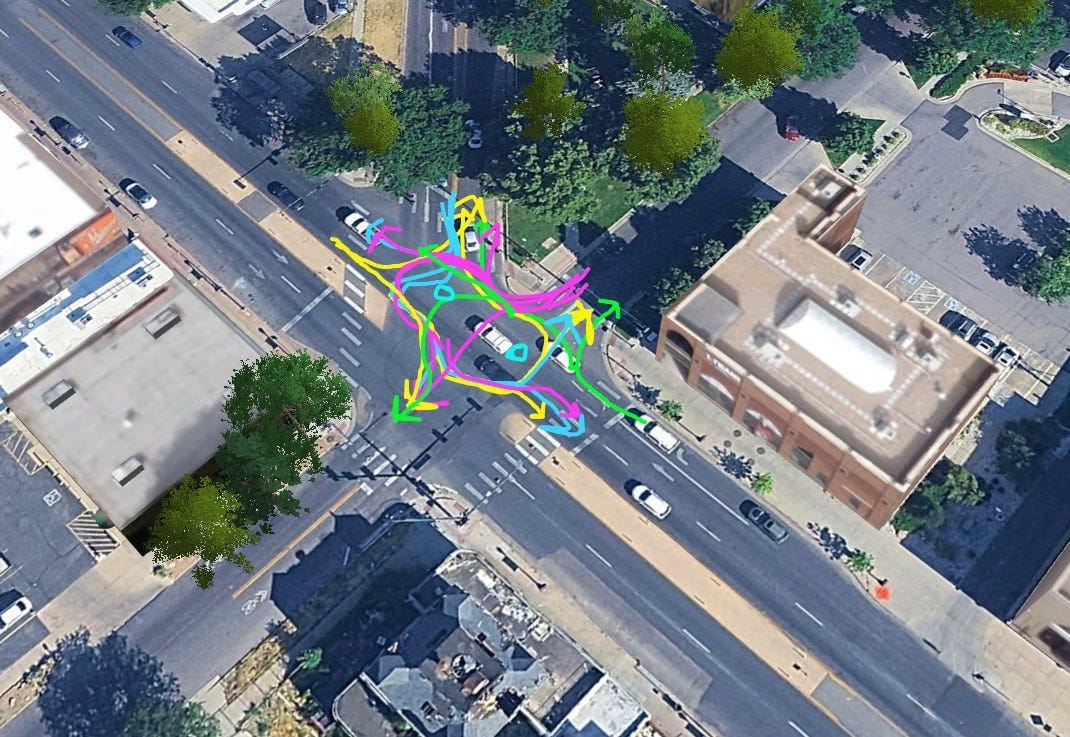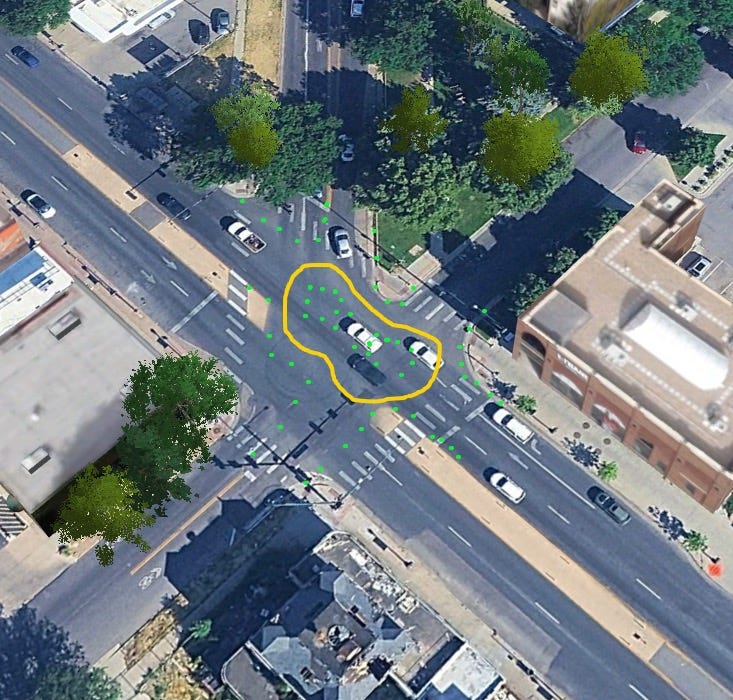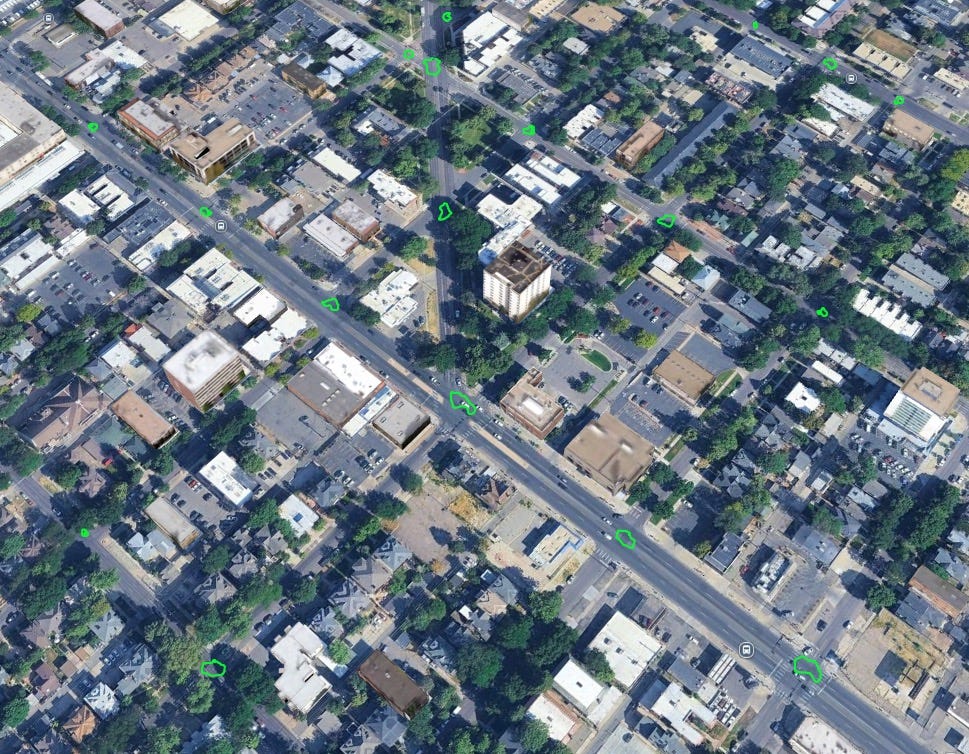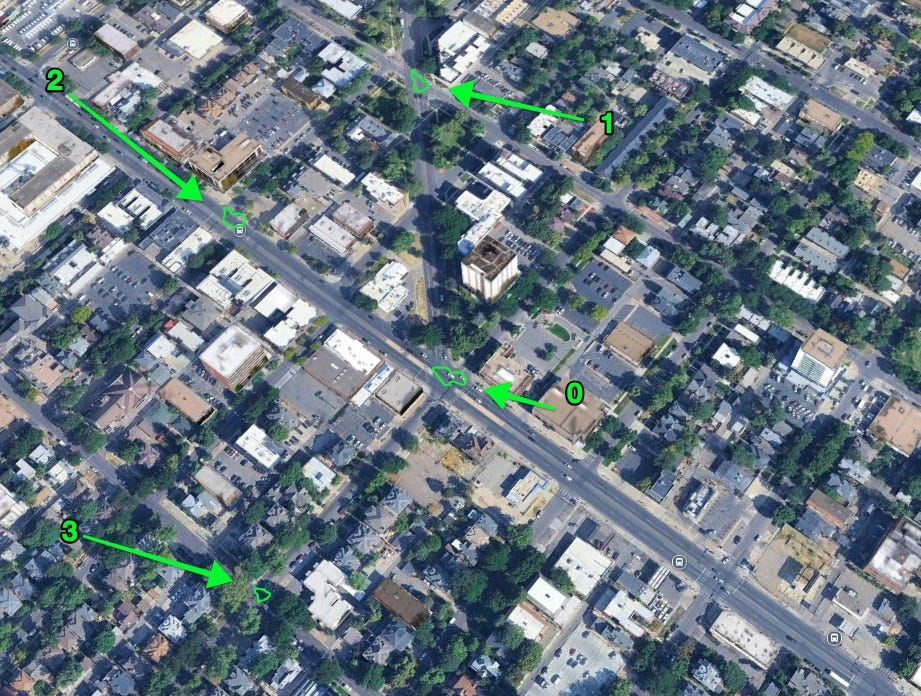A Pattern of Repair: The "Traffic Bean"
A description of *deeply* improved norm for mobility network junctions
Currently, especially to those who live in the greater united states, one might be familiar with a few different kinds of ‘controlled’ intersections.
An intersection managed by a light cycle that cycle between red, green, yellow, for all inbound traffic.
Other intersections might have one or more inbound lanes managed by stop signs.
I’m proposing the traffic bean as an alterantive to any intersection currently managed by a traffic light.
This is going to be perhaps image-heavy, of google maps overlays.
As I survey what I anticipate myself to be about to write, I anticipate that it’ll be graspable, even by a skim.
If, by the end of reading these words, the idea of a ‘bean shaped traffic device’ or ‘a traffic bean’ or ‘bean-shaped traffic curve’ or ‘bean shaped traffic circle’ brings anything specific to mind, our minds successfully connected.
If, after reading this post, you have an idea of how every intersection has a specific, calculatable value for ‘vehicles per square foot per minute’, our minds have really connected, in a way that reflects highly on you, because, well, you’ll see why.
0.002 vehicles per square foot per minute, is the value we come up with, by the way, for the intersection efficiency per sq foot. The answer to another measure of efficiency is “twenty one vehicles per minute”.
It’s challenging to describe some existing dynamics around light cycles, turns into/across the junction, and more. People achieve challenging projects, routinely.
Here’s an example of a particularly complicated intersection, one that I must, regrettably, interact with quite often:
It’s Colefax & Park & Franklin, in Denver, all in a massive, five-way junction. Here’s a link to the above google maps satellite vie
When I say “I want to see this junction fixed with a traffic bean”, I mean a bean-shaped traffic circle type thing, in the style of Poynton, UK. It’s a lumpy traffic curve, mixed with some ‘shared space’ affordances, that brings all sorts of nice things to everyone, including the drivers themselves.
The bean idea is perhaps also well-encountered through this excellent youtube video:
A rendering:
The finished product:
The “bean” to which I refer is the bean shape from the rendering. It’s not a circle, it’s sorta a figure 8, but doesn’t have to be. I’m calling it a bean.
Here’s the shape of fava beans, so between a traditional bean shape and a fava bean shape, I think “bean shaped junction” is the perfect terminology:
Here’s how a traffic bean could look brought to Colefax. I’m dropping the extra lanes that would no longer be needed - all inbound/outbound traffic would get funneled down to a single lane, so there would be a lot of space opened up.
These extra lanes on Colefax are already being turned over to bus rapid transit, and hopefully pedestrians.
I humbly propose that the vehicles per square foot per minute is plausibly an order of magnitude higher in the latter configuration, the traffic bean configuration, than in the current setup.
There would also be:
an order-of-magnitude reduction in pollution
an order-of-magitude decrease in common dangerous interactions between all objects moving through the space.
By my math, that means there are three separate order-of-magnitude improvements on deck for a relatively modest change.
We’d have to square some things away with a city engineer, and a traffic control company to sign off on the usage of their material, and perhaps a letter from a local city councelor that they are down with what is being done. These things would address police concerns and citizen concerns, and once the thing was set up and in operation, it would have it’s own influence on the discussion.
If someone interacted with this intersection in any meaningful way regularly, or was responsible for anything dependent upon this junction, I think we would all agree that this could be a most desired outcome.
Not bad, for something that can be done initially/temporarily with traffic cones.
Some things about the current junction
The light cycle is such that there are three different stages, which means two of the stages are closed to passage, always.
In addition to the time between each stage where the entire intersection is left empty to vehicles, for one stage to finish and the next to begin.
Green is the main Colefax light cycle. Yellow is Franklin, blue is Park:
Does that look complicated to you? It does to me.
This doesn’t even touch or attempt to display how complicated and large this intersection is for people using it via sidewalk/crosswalk. That’s too big to touch just yet.
When one of those cycles is going, the other cycles are stopped. The intersection spends so much time in a yellow/red cycle that it’s completely empty, much of the time, even though there are cars stopped and waiting to go through it from other directions.
Here’s some live, real time lapse drone video from this intersection:
and more:
 Tiktok failed to load.
Tiktok failed to load.Enable 3rd party cookies or use another browser
More footage:
Calculating Vehicle/square meter/minute ratio
That last video talks about determining the intersection vehicles-per-meter/minute value, lets touch on that real quick, it’s relevant for this ‘traffic bean’ conversation.
The following marked polygon is 11,700 sq feet, or 1100 sq meters:
I counted as part of the intersection everything inside of, inclusive of, the lines where vehicles would be expected to stop. Thus, one could say plausibly, as an answer to “what is the area of this junction?”:
The Colefax/Franklin/Park junction is 12,000 sq feet.
That figure is not yet necessarily interesting, alivened. To get an “intersection efficiency” value, we might do some counting while watching the following video:
in the above video, in a countinuous two minute shot, from 0:53-2:50, approx, I counted 43 vehicles that entered the intersection, which would 21 vehicles/minute can fit through the intersection, in certain conditions.
Does 21 vehicles per minute sound like a lot or a little, to you?
So, the intersection ‘efficiency ratio’, based off that 21 vehicles/minute in an intersection of 11,000 sq feet, to be something like:
Vehicles per square foot per minute=Area in square feet/Vehicles per minute:
Vehicles per square foot per minute=11,000 square feet/21vehicles per minute≈0.00191vehicles per square foot per minute
We’ll round that to 0.002 vehicles per square foot per minute, for this junction.
This gives us a very useful starting point.
So, consider watching some of or all of this video about Poytnton, UK:
That finished junction is the same size as the Colefax junction we’re evaluating. 11,000 sq feet:
Because there is no light cycle, there will never be a time when the junction is empty, while someone is waiting to enter it. It has many upsides, compared to american-style junctions.
I couldn’t get long clips of the pointon intersection in usage, but it was easy to see that it looked like a lot more than twenty vehicles per minute.
Here’s how it gets used:
I am calling this approximate shape ‘the traffic bean’:
It’s an irregular bean shape, though I bet a normal bean shape would serve well too:
Here’s another way of showing the shape of the junction:
If someone gave you a stack of traffic cones, and pointed to some asphalt, do you think you could re-create the approximate above shape somewhere? I know plenty of you could. Lets try Colefax, Park, Franklin:
It might look strange overlayed on Colefax right now because of how wide Colefax is - the inbound traffic would be brought to a single lane each direction (which is, in fact, how colefax is functioning right now because of a bus rapid transit project they’re working on - the intersection is functioning at an even WORSE vehicle/meter/minute ratio than usual, currently. :(
Here’s how the flow would be:
If you watched the poynton video, you’ll see why there might sometimes be people passing straight across colefax, rather than around the outside of the bean shape. It all depends on time of day, and how other users in the space are already using it.
If the bean shape was connected between the ends, there would be no drivers crossing the center. If it wasn’t connected, maybe there would be in some conditions.
This could obviously be initially constructed out of nothing more permanant and heavy-duty than traffic cones.
Here’s how the intersection would be changed, all within compliance of current road engineering guidelines at federal and municipal levels.
Signage on inbound vehicle lanes that says “shared space ahead”, followed by visual queues that something is different. Shaping the lanes down to one, with cones, and a gentle deviation of the straight-line inbound road would be sufficient.
cones dotted down, outlining an inner traffic-circle/bean type thing
cones dotted down, outlining the shape and openings for the inbound/outbound vehicles
once the resulting shape looks sorta bean-like, you’ve got the junction sorted!
Here’s my theorized treatment, with cones, of colefax/park/franklin:
The green dots would start as traffic cones, until everything felt right, then could be converted into prettier fixtures.
Because the ‘shapes’ are defined by points, it’s permiable to people on foot, and on bike, AND the vehicles passing around the bean would casually give way to the other users in the junction.
This would eliminate racing behavior, and making heavy use of the brakes or gas.
TODO insert link to currently-drafted-but-not-published post about ‘coning’ junctions
Vehicles would move through the space smoothly at a comfortable speed, instead of some vehicles moving through the intersection at 50 mph.
Ther would be bollards, not just for the above 50mph situation, but also someone drifting out of position at 10 mph. We wouldn’t want a pedestrian to get crushed and killed because a driver failed to maintain control of their vehicle. For more on that: Bollards: What and Why (josh.works) .
Extensions
I’d propose that this traffic bean pattern could be done again on an adjacent intersection, and on another adjacent intersection. Once a driver has passed through this intersection, they’d already be aware of things being new/different.
Adjacent intersections would logically deserve/easily receive the same traffic bean treatment. Obviously things learned doing the first one would be gracefully re-applied/modified/refined with modifying a second junction. and a third.
If one can achieve smooth, continuous flow through a junction in one spot, theoretically, one could do it again and again.
Here’s what might make sense for copying from one intersection to another:
Would you support that treatment? Would you do those intersections? I walk, drive, scoot alone and with others through this area all the time. This might be how I’d do it.
Can you imagine how this bean-shaped device could mediate traffic in a three, four, or five way junction? That it could perform without a green, yellow, red light cycle, and as long as there were cars waiting to proceed through it, it would be in operation?

